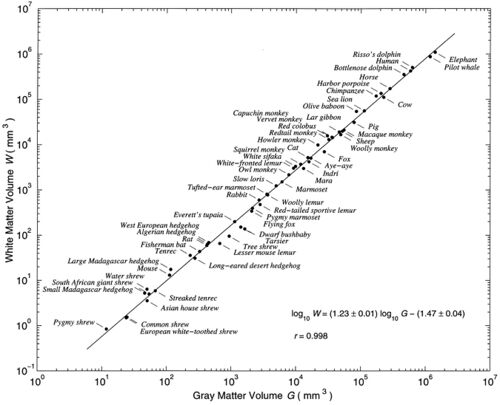Cerebral cortex: Difference between revisions
imported>Daniel Mietchen (slight brushing) |
imported>Daniel Mietchen m (typo) |
||
| Line 3: | Line 3: | ||
{{Image|Pnas.090504197.jpg|right|500px|[[Power law]] relationship between cortical [[white matter]] and [[gray matter]] across 56 species of [[mammal]]s.}} | {{Image|Pnas.090504197.jpg|right|500px|[[Power law]] relationship between cortical [[white matter]] and [[gray matter]] across 56 species of [[mammal]]s.}} | ||
The '''cerebral cortex''' represents the outermost tissue layers within the [[telencephalon]] (aka as ''cerebrum'') of [[vertebrate]]s. It can be subdivided into the [[neocortex]], the [[ | The '''cerebral cortex''' represents the outermost tissue layers within the [[telencephalon]] (aka as ''cerebrum'') of [[vertebrate]]s. It can be subdivided into the [[neocortex]], the [[hippocampal formation]] and the [[olfactory cortex]]. Together with the [[basal ganglia]], the cerebral cortex forms the [[gray matter]] of the [[brain]] which contains large numbers of [[nerve cell]] bodies and is connected by [[white matter]], characterized by [[myelin]]ated [[nerve fibre]]s. In [[reptile]]s, the cortex consists of three layers, in [[mammal]]s of six. In larger mammals, it is folded into [[gyrus|gyri]] and [[sulcus|sulci]] which increases the cortical surface area relative to the cortical volume — a process known as [[gyrification]]. The [[cortical thickness|thickness of the cerebral cortex]] varies between different regions, with values from around 2mm to 4mm being normal in mammals. Changes in cortical thickness correlate with both [[brain maturation]] and [[aging]] and are especially pronounced in [[dementia]]. | ||
==Ontogeny== | ==Ontogeny== | ||
Three main processes govern the development of the cerebral cortex: [[cell proliferation|proliferation]] of [[neural]] [[progenitor cell]]s, [[neuronal migration]] and the establishment of [[brain connectivity]] via [[synaptic pruning]] and [[myelination]]. These processes are most important during [[fetal development|fetal]] and early [[postnatal development]] but continue throughout life, with a second maximum during [[adolescence]], particularly in the [[forebrain]]. | Three main processes govern the development of the cerebral cortex: [[cell proliferation|proliferation]] of [[neural]] [[progenitor cell]]s, [[neuronal migration]] and the establishment of [[brain connectivity]] via [[synaptic pruning]] and [[myelination]]. These processes are most important during [[fetal development|fetal]] and early [[postnatal development]] but continue throughout life, with a second maximum during [[adolescence]], particularly in the [[forebrain]]. | ||
Revision as of 05:28, 6 November 2009
This article uses direct referencing.

Power law relationship between cortical white matter and gray matter across 56 species of mammals.
The cerebral cortex represents the outermost tissue layers within the telencephalon (aka as cerebrum) of vertebrates. It can be subdivided into the neocortex, the hippocampal formation and the olfactory cortex. Together with the basal ganglia, the cerebral cortex forms the gray matter of the brain which contains large numbers of nerve cell bodies and is connected by white matter, characterized by myelinated nerve fibres. In reptiles, the cortex consists of three layers, in mammals of six. In larger mammals, it is folded into gyri and sulci which increases the cortical surface area relative to the cortical volume — a process known as gyrification. The thickness of the cerebral cortex varies between different regions, with values from around 2mm to 4mm being normal in mammals. Changes in cortical thickness correlate with both brain maturation and aging and are especially pronounced in dementia.
Ontogeny
Three main processes govern the development of the cerebral cortex: proliferation of neural progenitor cells, neuronal migration and the establishment of brain connectivity via synaptic pruning and myelination. These processes are most important during fetal and early postnatal development but continue throughout life, with a second maximum during adolescence, particularly in the forebrain.